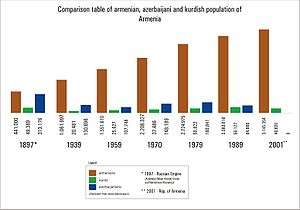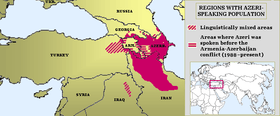Western Azerbaijan (political concept)

Western Azerbaijan (Azerbaijani: Qərbi Azərbaycan) is an irredentist political concept that is used in the Republic of Azerbaijan mostly to refer to the territory of the Republic of Armenia. Azerbaijani statements claim that the territory of the modern Armenian republic were lands that once belonged to Azerbaijanis.[1] Its claims are primarily hinged over the contention that the current Armenian territory was under the rule of various Turkic tribes, empires and khanates from the late medieval period until the Treaty of Turkmenchay signed after the Russo-Persian War, 1826-1828. The concept has received official sanction by the government of Azerbaijan, and has been used by its current president, Ilham Aliyev, who has repeatedly stated that the territory of Armenia is a part of "ancient Turk and Azerbaijani land."[2]
History
The present-day territory of Armenia and the western part of Azerbaijan is historically known as Armenian Highlands.[4]
In the medieval era, the Oghuz Turkic Seljuks, Kara Koyunlu and Ak Koyunlu held sway in the region. Afterward the area was under the control of the Safavid Empire.
Under the Iranian Safavids, the area that constitutes the bulk of the present-day Republic of Armenia, was organized as the Erivan Province. The Erivan Province also had Nakhchivan as one of its administrative jurisdictions. A number of the Safavid era governors of the Erivan Province were of Turkic origin. Together with the Karabagh province, the Erivan Province comprised Iranian Armenia.[5][6]
Iranian ruler Nader Shah (r. 1736-1747) later established the Erivan Khanate (i.e. province); from then on, together with the smaller Nakchivan Khanate, these two administrative entities constituted Iranian Armenia.[7] In the Erivan Khanate, the Armenian citizens had partial autonomy under the immediate jurisdiction of the melik of Erevan.[8] In the Qajar era, members of the royal Qajar dynasty were appointed as governors of the Erivan khanate, until the Russian occupation in 1828.[9] The heads of the provincial government of the Erivan Khanate were thus directly related to the central ruling dynasty.[10]
In 1828, per the Treaty of Turkmenchay, Iran was forced to cede the Erivan and Nakhchivan Khanates to the Russians. These two territories, which had constituted Iranian Armenia prior to 1828, were added together by the Russians and then renamed into the "Armenian Oblast".
Demographic basis
.jpg)

Until the mid-fourteenth century, Armenians had constituted a majority in Eastern Armenia.[11] At the close of the fourteenth century, after Timur's campaigns, Islam had become the dominant faith, and Armenians became a minority in Eastern Armenia.[11] After centuries of constant warfare on the Armenian Plateau, many Armenians chose to emigrate and settle elsewhere. Following Shah Abbas I's massive relocation of Armenians and Muslims in 1604-05,[12] their numbers dwindled even further.
Some 80% of the population of Iranian Armenia were Muslims (Persians, Turkics, and Kurds) whereas Christian Armenians constituted a minority of about 20%.[13] As a result of the Treaty of Gulistan (1813) and the Treaty of Turkmenchay (1828), Iran was forced to cede Iranian Armenia (which also constituted the present-day Republic of Armenia), to the Russians.[7][14]
After the Russian administration took hold of Iranian Armenia, the ethnic make-up shifted, and thus for the first time in more than four centuries, ethnic Armenians started to form a majority once again in one part of historic Armenia.[15] The new Russian administration encouraged the settling of ethnic Armenians from Iran proper and Ottoman Turkey. As a result, by 1832, the number of ethnic Armenians had matched that of the Muslims.[13] Anyhow, it would be only after the Crimean War and the Russo-Turkish War of 1877-1878, which brought another influx of Turkish Armenians, that ethnic Armenians once again established a solid majority in Eastern Armenia.[16] Nevertheless, the city of Erivan remained having a Muslim majority up to the twentieth century.[16] According to the traveller H. F. B. Lynch, the city was about 50% Armenian and 50% Muslim (Azerbaijanis and Persians) in the early 1890s.[8]
According to the Russian census of 1897, a significant population of Azeris still lived in Russian Armenia. They numbered about 300,000 persons or 37.8% in Russia's Erivan Governorate (roughly corresponding to most of present-day central Armenia, the Iğdır Province of Turkey, and Azerbaijan's Nakhichevan exclave, but excluding Zangezur and most of northern Armenia). Most lived in rural areas and were engaged in farming and carpet-weaving. They formed the majority in 4 of the governorate's 7 districts (including Igdir and Nakhichevan, which are not part of Armenia today and Sharur-Daralagyoz district which is mostly in Azerbaijan) and were nearly as many as the Armenians in Yerevan (42.6% against 43.2%).[17] At the time, Eastern Armenian cultural life was centered more around the holy city of Echmiadzin, seat of the Armenian Apostolic Church.[18]
At the beginning of the 20th century, there were 149 Azerbaijani, 91 Kurdish and 81 Armenian villages in Zangezur.[19] Traveller Luigi Villari reported in 1905 that in Erivan the Tatars (modern-day Azerbaijanis) were generally wealthier than the Armenians, and owned nearly all of the land.[20]
Some Azeri sources claim that currently there is not a single Azerbaijani in Armenia.[21]
See also
References
- ↑ "Present-day Armenia located in ancient Azerbaijani lands - Ilham Aliyev". News.Az. October 16, 2010.
- ↑ See, for example, (in Azerbaijani) Ilham Aliyev's speech in Baku. "We do not argue any territorial claim against Armenia. However we can, because the territory which present-day Armenia locates is an ancient Turk and Azerbaijani land"
- ↑ See Hovannisian, Richard G. (1982). The Republic of Armenia, Vol. II: From Versailles to London, 1919-1920. Berkeley: University of California Press. pp. 192, map 4, 526–529. ISBN 0-520-04186-0.
- ↑ A. West, Barbara (2008). Encyclopedia of the Peoples of Asia and Oceania, Volume 1. Facts on File. p. 52. ISBN 0-8160-7109-8.
- ↑ Bournoutian 2006, p. 213.
- ↑ Payaslian 2007, p. 107.
- 1 2 Bournoutian 1980, pp. 1-2.
- 1 2 Kettenhofen, Bournoutian & Hewsen 1998, pp. 542-551.
- ↑ "Iranians, in order to save the rest of eastern Armenia, heavily subsidized the region and appointed a capable governor, Hosein Qoli Khan, to administer it." -- A Concise History of the Armenian People: (from Ancient Times to the Present), George Bournoutian, Mazda Publishers (2002), p. 215
- ↑ Bournoutian 2004, pp. 519-520.
- 1 2 Bournoutian 1980, pp. 11, 13-14.
- ↑ Arakel of Tabriz. The Books of Histories; chapter 4. Quote: "[The Shah] deep inside understood that he would be unable to resist Sinan Pasha, i.e. the Sardar of Jalaloghlu, in a[n open] battle. Therefore he ordered to relocate the whole population of Armenia - Christians, Jews and Muslims alike, to Persia, so that the Ottomans find the country depopulated."
- 1 2 Bournoutian 1980, pp. 12-13.
- ↑ Mikaberidze 2015, p. 141.
- ↑ Bournoutian 1980, p. 14.
- 1 2 Bournoutian 1980, p. 13.
- ↑ Russian Empire Census 1897
- ↑ Thomas de Waal. Black Garden: Armenia And Azerbaijan Through Peace and War. New York: New York University Press, p. 74. ISBN 0-8147-1945-7
- ↑ (in Russian) Кавказский календарь на 1900 г., III Отдел. Статист. свед. с. 42-43, Елизаветпольская губерния. Свод статистических данных извлеченных из посемейных списков населения Кавказа., Тифлис, 1888, с.V
- ↑ Fire and Sword in the Caucasus by Luigi Villari. London, T. F. Unwin, 1906: p. 267
- ↑ (in Azerbaijani) Qərbi Azərbaycanla bağlı toponimlər barədə nə bilirik, Sevinj Rza qizi 2010, azpress.az, 6 August, access date: 2 October 2010
Sources
- Bournoutian, George A. (1980). "The Population of Persian Armenia Prior to and Immediately Following its Annexation to the Russian Empire: 1826-1832". The Wilson Center, Kennan Institute for Advanced Russian Studies.
- Bournoutian, George A. (2004). "ḤOSAYNQOLI KHAN SARDĀR-E IRAVĀNI". Encyclopaedia Iranica, Vol. XII, Fasc. 5. pp. 519–520.
- Bournoutian, George A. (2006). A Concise History of the Armenian People (5 ed.). Costa Mesa, California: Mazda Publishers,. pp. 214–215. ISBN 1-56859-141-1.
- Kettenhofen, Erich; Bournoutian, George A.; Hewsen, Robert H. (1998). "EREVAN". Encyclopaedia Iranica, Vol. VIII, Fasc. 5. pp. 542–551.
- Mikaberidze, Alexander (2015). Historical Dictionary of Georgia (2 ed.). Rowman & Littlefield. ISBN 978-1442241466.
- Payaslian, Simon (2007). The History of Armenia: From the Origins to the Present. Palgrave Macmillan. ISBN 978-0230608580.
